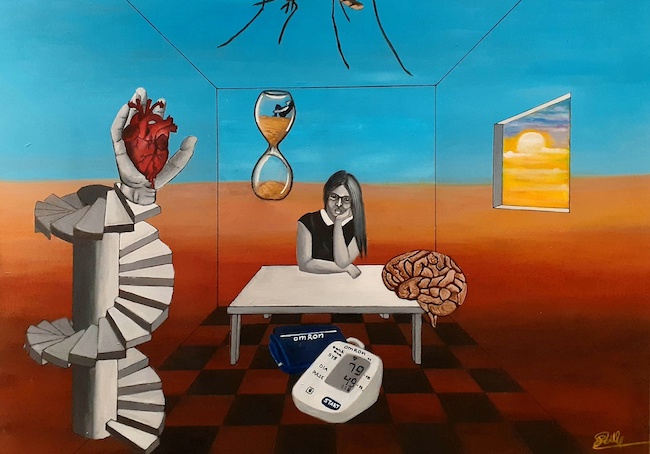Le inquietudini, le preoccupazioni, l’instabilità del vivere attuale sono spesso oggetto di riflessione e, di conseguenza, di manifestazione espressiva di molti artisti, filtro interpretativo dei tempi in cui si trovano a vivere; alcuni scelgono il linguaggio immediato ed ermetico dell’Astrattismo per non ingabbiare le emozioni provate all’interno dei confini della figurazione, altri invece pur rimanendo orientati a un approccio più fedele alla realtà osservata, giocano sul senso e sul non senso per donare all’osservatore uno spunto di riflessione. La protagonista di oggi appartiene a quella categoria di creativi che manifesta il bisogno di partire dalla realtà per spingersi oltre, superarla e giungere al significato profondo delle cose.
Quando agli inizi del Ventesimo secolo un gruppo di artisti, impressionati dagli studi sulla psiche umana compiuti dal grande neurologo e psicanalista austriaco Sigmund Freud, decisero di creare un movimento pittorico, il Surrealismo, attraverso cui dare voce al mondo dell’inconscio che si liberava in particolar modo nel momento del sonno, i disagi interiori ed esistenziali erano decisamente differenti da quelli dei tempi che viviamo oggi. Gli orrori della prima guerra mondiale erano appena stati superati e gli artisti avevano compreso la fugacità della vita, le angosce ancora intrappolate nelle interiorità colpite e fortemente impressionate da tutto ciò che era stato visto, tragicamente vissuto e spesso perduto durante il conflitto; dunque il bisogno di esternare quelle sensazioni dolorose e opprimenti doveva manifestarsi attraverso uno stile pittorico in cui l’occhio potesse essere catturato da immagini conosciute per poi entrare in una dimensione onirica, irreale, fatta di oggetti decontestualizzati e significanti altro dal loro utilizzo ordinario. L’universo inquietante delle tele di Salvador Dalì altro non era che esternazione del suo concetto di vivere, del trascorrere del tempo, degli incubi nei quali si perdeva, spesso a sfondo erotico, contraddistinti da una morbosità di fondo che attraeva e calamitava l’attenzione dell’osservatore; di contro, gli scenari post-apocalittici di Yves Tanguy, popolati da personaggi impalpabili e privi di identità, quasi inconsistenti, manifestavano tutto il suo turbamento nei confronti di un’umanità in balìa di se stessa, delle sue medesime debolezze a causa delle quali prevaricare l’altro o sottometterlo poteva divenire, come d’altronde era già avvenuto, causa scatenante di lotte e di distruzioni. E poi c’era Rene Magritte, con quella sua inclinazione a studiare la mente umana in maniera delicata, facendone emergere non più gli istinti primordiali come i suoi due colleghi, bensì spostandosi in un universo più riflessivo, più orientato a scoprire il mistero che si nasconde nelle pieghe di una quotidianità falsamente ordinaria dentro cui l’uomo si rifugia, rassicurato, per evitare di aprirsi a una conoscenza più profonda, più metafisica di un sé che non conosce e di una realtà esterna altrettanto enigmatica.
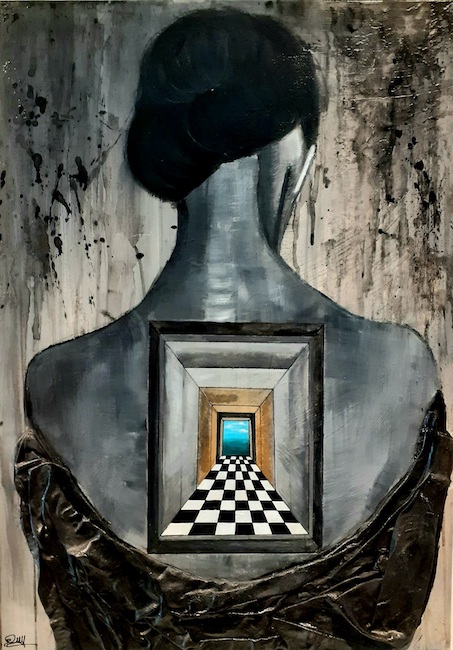
Lo stile pittorico dell’artista piemontese Elisa La Manna rappresenta un punto di unione tra il Surrealismo più puro, quello attraverso cui lasciar emergere ansie e inquietudini della vita attuale, e la meditazione della Metafisica attraverso la quale fuoriesce il suo approccio curioso e attento alle molteplici sfaccettature che appartengono al vivere contemporaneo; ha uno sguardo un po’ ironico e un po’ sagace l’artista, proprio per la sua capacità di osservare dettagli, raccontare frangenti che sembrano nasconderne altri, che si dividono o si collocano all’interno di situazioni differenti da quelle abituali, per svelare la profondità che spesso si nasconde dietro l’apparenza.
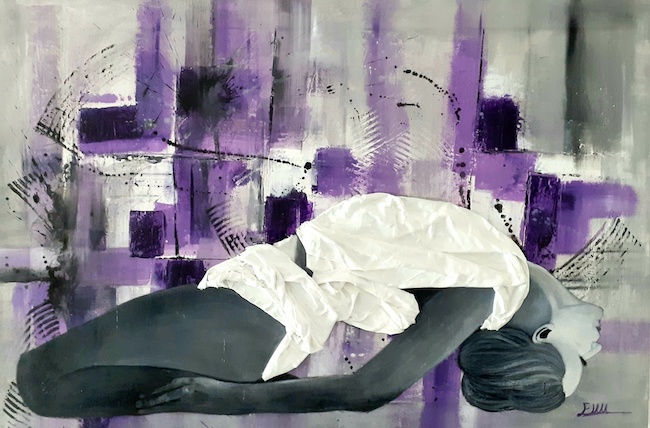
Ogni sua opera apre un mondo diverso da quello percepito a un primo sguardo, il senso più consistente emerge dopo essersi soffermati, o meglio aver lasciato che l’immagine principale, piuttosto che la versione di insieme, conquistasse l’attenzione in virtù dell’armonia estetica per poi guidare la riflessione verso un livello più intimo, più concettuale, più ponderato perché guidato dall’abilità della La Manna a scoprire dettagli inizialmente rimasti in silenzio. La sua è un’attenta riflessione sull’esistenza e su tutto ciò che ne fa parte, pensieri, pulsioni, timori, percezioni inconsce che premono per giungere alla consapevolezza, riflessione dalla quale emerge anche la sua capacità di accettare la stranezza, la bizzarria che avvolge il quotidiano e che induce l’essere umano ad assuefarsi agli eventi cercando di trovare in essi un senso necessario a superare gli ostacoli che costituiscono o introducono.
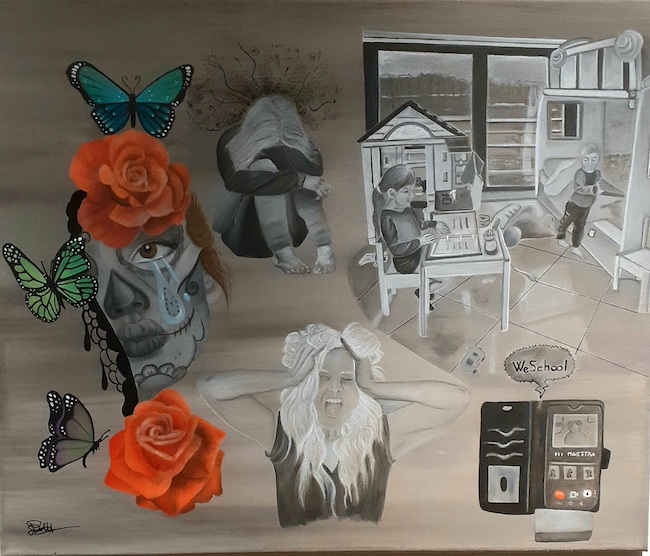
Nella tela Sovraccarico mentale Elisa La Manna racconta delle costrizioni subite dall’individuo a causa del periodo pandemico, quell’essere costretto a un isolamento non scelto, non voluto, che ha provocato in particolar modo nei giovani il disagio di non poter condividere, di non poter socializzare in una fase importante dell’esistenza; il silenzio, la disperazione, la sensazione di soffocamento per essere costretti a stare in casa emerge dall’opera in maniera chiara, schietta, spontanea, così come è sottolineata l’inconsapevolezza dei bambini incapaci di trovare un senso a quanto stava accadendo ma in qualche modo convinti ad accettare quel radicale cambiamento che li costringeva a non andare a scuola, a non vedere i propri compagni, a non poter giocare.
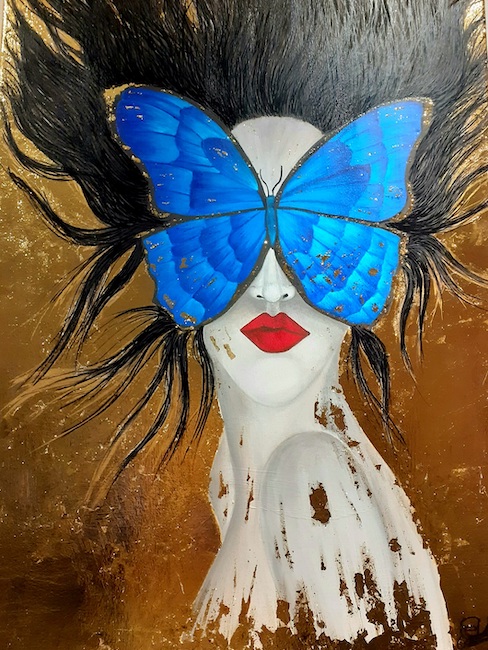
In volo come farfalle sembra essere collegata ma opposta all’opera precedente, una celebrazione del sogno di libertà, di potersi astrarre dalla contingenza e volare via leggeri come farfalle, è questo il sogno della La Manna, l’auspicio di libertà che ciascun individuo merita di avere, senza che i suoi progetti siano arrestati od ostacolati dalla contingenza, senza che qualcuno o qualcosa possa impedirne la realizzazione. È un invito alla forza, alla resilienza, al trovare il coraggio per coltivare la propria originalità e individualità anche laddove il mondo circostante voglia rassegnarsi ad altro, adeguandosi a un pragmatismo che cancella i desideri e i sogni.
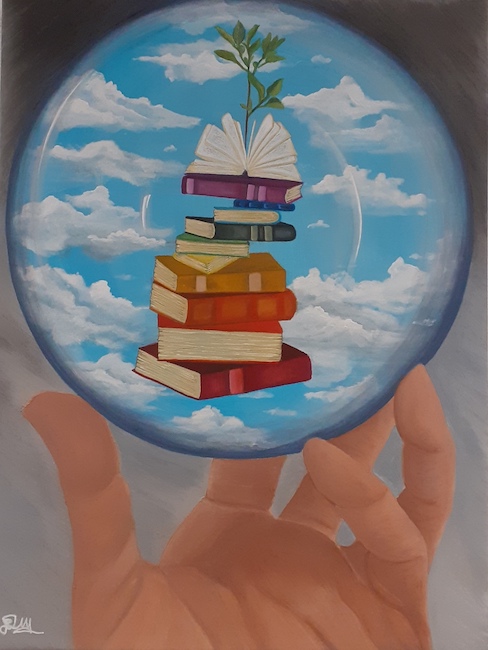
In La cultura rende liberi l’artista sottolinea quanto nell’era contemporanea ci si dimentichi di aprire le pagine di un libro, immaginare e comprendere i concetti elaborandoli attraverso il proprio pensiero piuttosto che affidarsi alla velocità tecnologica che rende l’essere umano spettatore passivo e gradualmente incapace di riflettere e approfondire; in questa tela emerge tutta la forza Metafisica dello stile di Elisa La Manna per la scelta di inserire una pila di libri all’interno di una sfera di cristallo sostenuta da una mano, quasi a voler sottolineare da un lato quanto sia importante proteggere e tutelare una conoscenza in virtù della quale mantenere il contatto con il passato e al tempo stesso avere una mente libera e aperta alla scelta del proprio futuro, e dall’altro quanto risieda nella scelta individuale di ogni singolo individuo il cogliere o meno l’opportunità di avvicinarsi a un metodo di apprendimento forse desueto rispetto ai tempi contemporanei, eppure ancora l’unico in grado di accompagnare verso una coscienza collettiva, storica e critica priva di condizionamenti.

Nella tela Il tempo l’artista riprende il tema della liquefazione dell’orologio appartenente al celeberrimo maestro del Surrealismo Salvador Dalì, per sottolineare quanto tutto sia relativo, quanto malgrado le giornate dell’uomo attuale siano scandite da impegni, scadenze e cose da fare che infondono l’illusione che tutto possa essere eterno, in realtà potrebbe non essere così, potrebbe tutto precipitare in vista di cambiamenti, modificazioni, prematuri eventi che potrebbero giungere in maniera improvvisa quanto imprevista. È in questa costante contrapposizione che si delinea la filosofia espressiva di Elisa La Manna, in questo sapere di avere davanti sempre la possibilità di scelta e optare spesso per la decisione più rassicurante che però di fatto si rivela essere quella meno lungimirante; l’uomo contemporaneo si intrappola a volte all’interno di meccanismi di causa ed effetto che lo inducono a dimenticarsi di essere libero ed è in questo che risiede la bizzarria dell’esistenza, l’assurdo che l’artista riesce sapientemente a lasciar emergere.
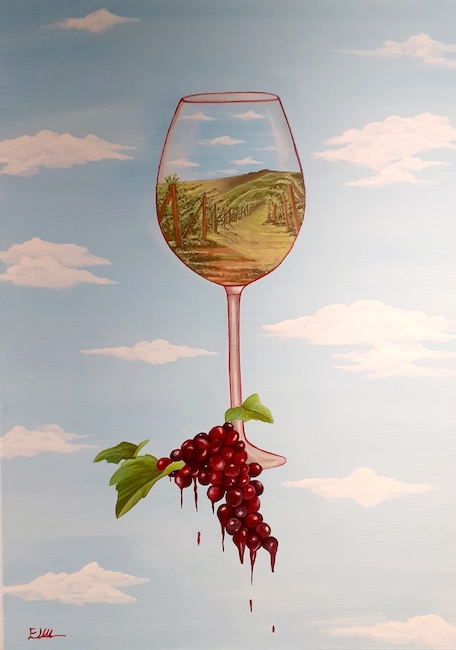
Foglia oro, resina epossidica, vino, caffè sono i materiali che mescola ai colori acrilici contraddistinguendola e permettendole di farsi notare in diversi concorsi in Italia e all’estero dove le sue tele sono state esposte.
ELISA LA MANNA-CONTATTI
Email: elisalamanna78@gmail.com
Facebook: https://www.facebook.com/elisa.lamanna.7
Linkedin: https://www.linkedin.com/in/elisa-la-manna-542b20212/
Instagram: https://www.instagram.com/elisalamanna/
The bizarre meaning of life narrated through surrelism by Elisa La Manna
The anxieties, worries and instability of today’s life are often the subject of reflection and, consequently, of expression by many artists, an interpretative filter of the times in which they find themselves living; some choose the immediate and hermetic language of Abstractionism so as not to cage the emotions felt within the confines of figuration, while others, despite remaining oriented towards an approach more faithful to the reality observed, play on meaning and non-sense to give the observer food for thought. Today’s protagonist belongs to that category of creatives who manifest the need to start from reality in order to go beyond it, to overcome it and reach the deeper meaning of things.
When, at the beginning of the 20th century, a group of artists, impressed by the studies on the human psyche carried out by the great Austrian neurologist and psychoanalyst Sigmund Freud, decided to create a pictorial movement, Surrealism, through which they could give voice to the world of the unconscious that was released particularly at the moment of sleep, the inner and existential discomforts were decidedly different from those of the times we live in today. The horrors of the First World War had just been overcome and the artists had understood the fleeting nature of life, the anguish still trapped in their inner selves, affected and strongly impressed by all that had been seen, tragically experienced and often lost during the conflict; therefore, the need to externalize these painful and oppressive sensations had to be manifested through a pictorial style in which the eye could be captured by familiar images and then enter a dreamlike, unreal dimension made up of decontextualised objects that signify something other than their ordinary use.
The disquieting universe of Salvador Dali’s canvases was nothing more than an externalization of his concept of living, of the passing of time, of the nightmares in which he lost himself, often with an erotic background, marked by an underlying morbidity that attracted and captivated the viewer’s attention; on the other hand, Yves Tanguy’s post-apocalyptic scenarios, populated by impalpable, identity-less, almost insubstantial characters, showed all his concern for a humanity at the mercy of itself, of its own weaknesses, whereby bullying or subjugating others could become, as had already happened, the cause of strife and destruction. And then there was Rene Magritte, with his inclination to study the human mind in a delicate way, no longer bringing out its primordial instincts like his two colleagues, but moving into a more reflective universe, more oriented towards discovering the mystery that hides in the folds of a falsely ordinary everyday life into which man takes refuge, reassured, to avoid opening up to a deeper, more metaphysical knowledge of a self that he does not know and of an equally enigmatic external reality. The pictorial style of Piedmontese artist Elisa La Manna represents a point of union between the purest Surrealism, through which she lets the anxieties and restlessness of current life emerge, and the meditation of Metaphysics through which her curious and attentive approach to the multiple facets of contemporary life emerges; the artist’s gaze is a little ironic and a little shrewd, precisely because of her ability to observe details, to recount junctures that seem to conceal others, that are divided or placed within situations that are different from the usual ones, to reveal the depth that is often hidden behind appearances.
Each of her artworks opens up a different world from the one perceived at first glance; the most consistent sense emerges after lingering, or better after letting the main image, rather than the overall version, win the attention by virtue of its aesthetic harmony, and then guiding the reflection towards a more intimate, more conceptual level, more pondered because guided by La Manna’s ability to discover details that initially remained silent. Hers is a careful reflection on existence and on everything that is part of it, thoughts, impulses, fears, unconscious perceptions that press on to reach awareness, a reflection from which emerges her ability to accept the strangeness, the bizarre that envelops everyday life and induces the human being to become accustomed to events, trying to find in them a meaning necessary to overcome the obstacles they create or introduce. In the canvas Mental Overload, Elisa La Manna tells of the constraints suffered by the individual as a result of the pandemic period, that being forced into an isolation that was not chosen, not wanted, which has provoked, especially in young people the discomfort of not being able to share, not being able to socialise in an important phase of existence; the silence, despair and feeling of suffocation at being forced to stay at home emerge clearly, frankly and spontaneously from the artwork, as does the unawareness of the children, unable to make sense of what was happening but somehow persuaded to accept the radical change that forced them not to go to school, not to see their friends and not to play. In flight like butterflies seems to be linked to but opposite to the previous work, a celebration of the dream of freedom, of being able to abstract oneself from contingency and fly away as lightly as butterflies.
This is La Manna’s dream, the wish for freedom that each individual deserves to have, without projects being stopped or hindered by contingency, without someone or something being able to prevent their realisation. It is an invitation to strength, to resilience, to find the courage to cultivate one’s own originality and individuality even when the surrounding world wants to resign to something else, adapting to a pragmatism that erases desires and dreams. In Culture makes you free, the artist emphasises how in contemporary times people forget to open the pages of a book, to imagine and understand concepts by elaborating them through one’s own thoughts rather than relying on the speed of technology, which makes the human being a passive spectator and gradually incapable of reflecting and investigating; the metaphysical strength of Elisa La Manna’s style emerges in this canvas through her choice to place a stack of books inside a crystal ball held by a hand, as if to underline on the one hand how important it is to protect and safeguard knowledge, by virtue of which maintaining a contact with the past and at the same time have a free and open mind to choose the future, On the other hand, it is up to each individual to decide whether or not to take the opportunity to approach a method of learning that is perhaps obsolete compared to contemporary times, yet still the only one capable of accompanying towards a collective, historical and critical consciousness free of conditioning.
In the painting Time, the artist takes up the theme of the liquefaction of the clock belonging to the famous master of Surrealism, Salvador Dali, to emphasise how relative everything is, how, despite the fact that the days of modern man are marked by commitments, deadlines and things to do that give the illusion that everything could be eternal, in reality this may not be the case, everything may be precipitated in view of changes, modifications, premature events that could come suddenly and unexpectedly. It is in this constant opposition that Elisa La Manna’s expressive philosophy is delineated, in this knowledge of always having the possibility of choice and often opting for the most reassuring decision which, in fact, turns out to be the least far-sighted one; contemporary man is sometimes trapped within cause and effect mechanisms that lead him to forget he is free and it is in this that the strangeness of existence lies, the absurdity that the artist skilfully succeeds in allowing to emerge. Gold leaf, epoxy resin, wine and coffee are the materials she mixes with acrylic colours, making her stand out and allowing her to be noticed in various competitions in Italy and abroad where her canvases have been exhibited.


